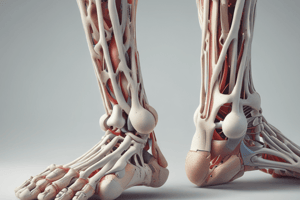Podcast
Questions and Answers
What is the approximate percentage of individuals who do well after a compression fracture without wound complications?
What is the approximate percentage of individuals who do well after a compression fracture without wound complications?
- 50%
- 100%
- 75% (correct)
- 90%
What is the primary goal when managing paediatric ankle fractures?
What is the primary goal when managing paediatric ankle fractures?
- Apply a below knee cast
- Reduce and hold or fix
- Use K-wires or cannulated screws
- Avoid injury to physis (correct)
What is the typical mechanism of injury for a talar neck fracture?
What is the typical mechanism of injury for a talar neck fracture?
- Forced plantarflexion with axial loading
- Forced inversion with axial loading
- Sudden dorsiflexion
- Forced dorsiflexion with axial loading (correct)
What is the common location of an Achilles tendon rupture?
What is the common location of an Achilles tendon rupture?
What is the age range when Achilles tendon ruptures are most common?
What is the age range when Achilles tendon ruptures are most common?
What is the anatomical composition of the Achilles tendon?
What is the anatomical composition of the Achilles tendon?
What is the primary restraint to talar shift?
What is the primary restraint to talar shift?
What percentage of ankle fractures are isolated malleolus fractures?
What percentage of ankle fractures are isolated malleolus fractures?
What is the indication for operative treatment in ankle sprains?
What is the indication for operative treatment in ankle sprains?
What is the purpose of stress views in the investigation of ankle sprains?
What is the purpose of stress views in the investigation of ankle sprains?
What is the outcome of ankle fractures in terms of recovery?
What is the outcome of ankle fractures in terms of recovery?
What type of injury is a pilon fracture?
What type of injury is a pilon fracture?
What is the main motion of the ankle joint?
What is the main motion of the ankle joint?
Which ligament is responsible for the integrity of the ankle mortise?
Which ligament is responsible for the integrity of the ankle mortise?
What is the most common type of ankle sprain?
What is the most common type of ankle sprain?
What is the motion of the fibula within the incisura fibularis during gait?
What is the motion of the fibula within the incisura fibularis during gait?
What is the percentage of ankle sprains that are high ankle sprains?
What is the percentage of ankle sprains that are high ankle sprains?
What is the mechanism of injury for a low ankle sprain?
What is the mechanism of injury for a low ankle sprain?
Flashcards are hidden until you start studying
Study Notes
Compression Fracture
- Takes approximately 4 months to heal
- Around 75% of patients do well without wound complications
- 10% risk of requiring ankle arthrodesis
Paediatric Ankle Fracture
- Salter Harris fractures are common
- Avoid injury to physis
- May use K-wires or cannulated screws to reduce physis injury
- Triplaner fracture requires CT scan
- Talus fracture is rare
Talus Fracture
- Talar neck fractures are high-energy injuries
- High incidence of talus avascular necrosis
- CT scan is usually required
- May associate with talus dislocation
- Treatment involves reduction and fixation
Talar Body Fracture
- Rare
- May be lateral process, posterior process, or talar head fracture
- Diagnosis involves X-ray and CT scan
- Treatment is usually non-operative unless the fracture is displaced or intra-articular
Achilles Tendon Rupture
- Common tendon injury
- Mechanism: Sudden dorsiflexion, often in sports
- Typically occurs in males aged 30-40
- Rupture usually occurs 4-6 cm above the insertion
- History: Patient feels a "pop" and experiences weakness and pain with weight-bearing
- Signs: Swelling, ecchymosis, tenderness, and positive anterior drawer test and talar tilt test
- Investigation: X-ray, stress views, and MRI
- Treatment: Non-operative or operative, depending on pain and instability
Ankle Fractures
- Very common
- Usually due to twisting injury
- Affect all ages
- Types: Isolated malleolus (70%), bimalleolar (20%), and trimalleolar (7%)
- Weber (Danis-Weber) classification:
- Type A: Below syndesmosis
- Type B: Trans syndesmosis
- Type C: Above syndesmosis
- Biomechanics: Deltoid ligament is primary restraint to talar shift, and fibula acts as buttress to prevent lateral talar shift
- Presentation: Symptoms and signs of pain, swelling, and deformity
- Investigation: X-ray, CT scan, and MRI
- Treatment: Non-operative or operative, depending on the severity of the fracture
- Outcome: Over 90% success rate, but full recovery may take a long time
Pilon Fracture
- Combination of ankle fracture and distal tibia fracture
- High-energy injury
- Significant associated soft tissue injury
- Around 25% are open fractures
- Mechanism: Vertical compression
Ankle Joint
- Bones: Tibial plafond, medial malleolus, lateral malleolus, and talus
- Motion: Plantar flexion, dorsiflexion, inversion, eversion, and rotation
- Ligaments: Medial, deltoid, lateral, anterior talofibular, posterior talofibular, calcaneal fibular, and lateral talocalcaneal
Distal Tibiofibular Joint
- Bones: Distal fibula and incisura fibularis
- Motion: Rotation during gait
- Ligaments: Syndesmosis, anterior inferior tibiofibular, posterior inferior tibiofibular, transverse tibiofibular, and interosseous
Ankle Sprain
- Very common
- Twisting injury
- Diagnosis: Clinical
- Treatment: Usually conservative
- Mechanism: Inversion injury in plantarflexed ankle
- High ankle sprain (syndesmosis injury) is less than 10% of ankle sprains
- Low ankle sprain (ATFL and CFL) is more than 90% of all ankle sprains
- Associated injuries: Osteochondral fractures, peroneal tendon injuries, and deltoid ligament injury
Studying That Suits You
Use AI to generate personalized quizzes and flashcards to suit your learning preferences.




